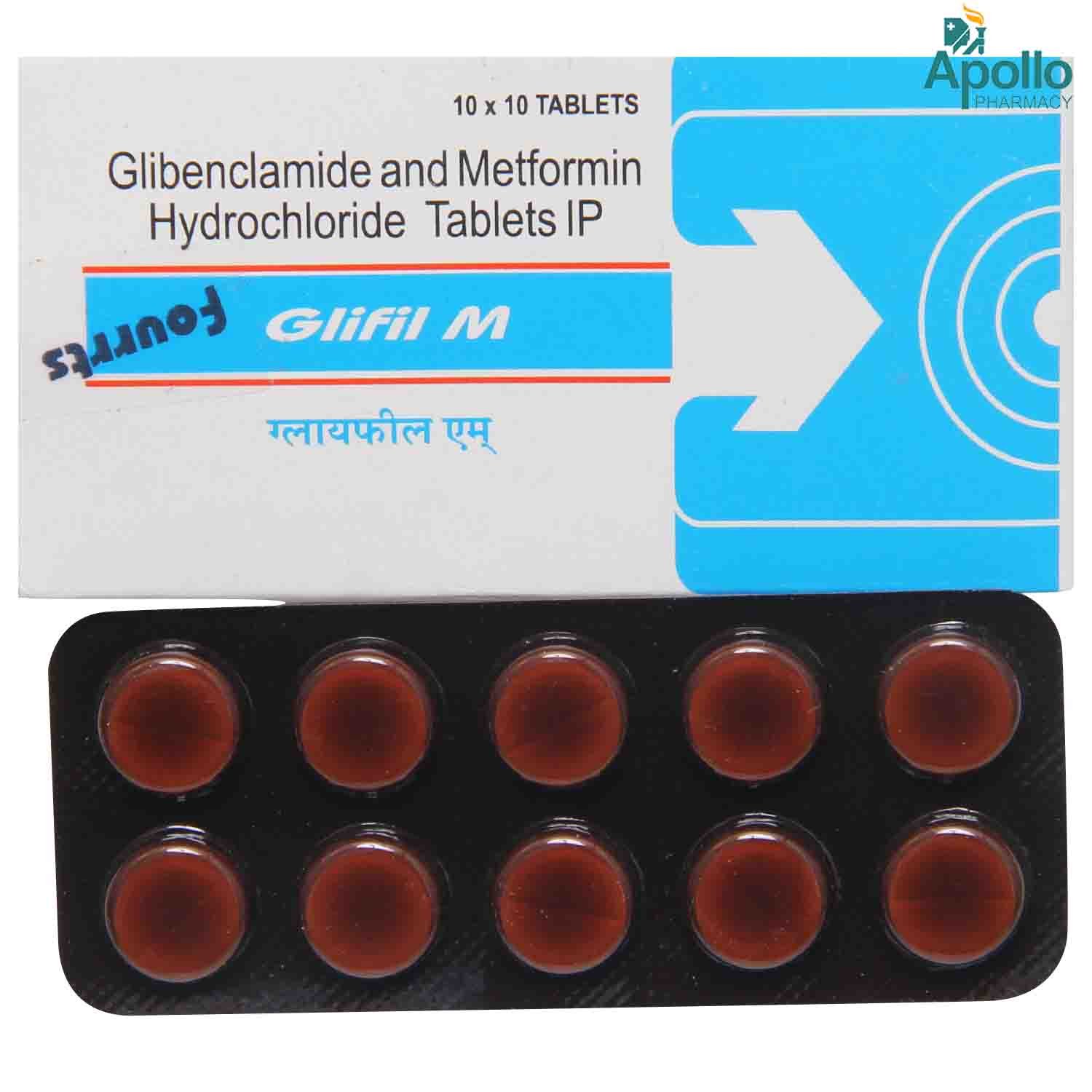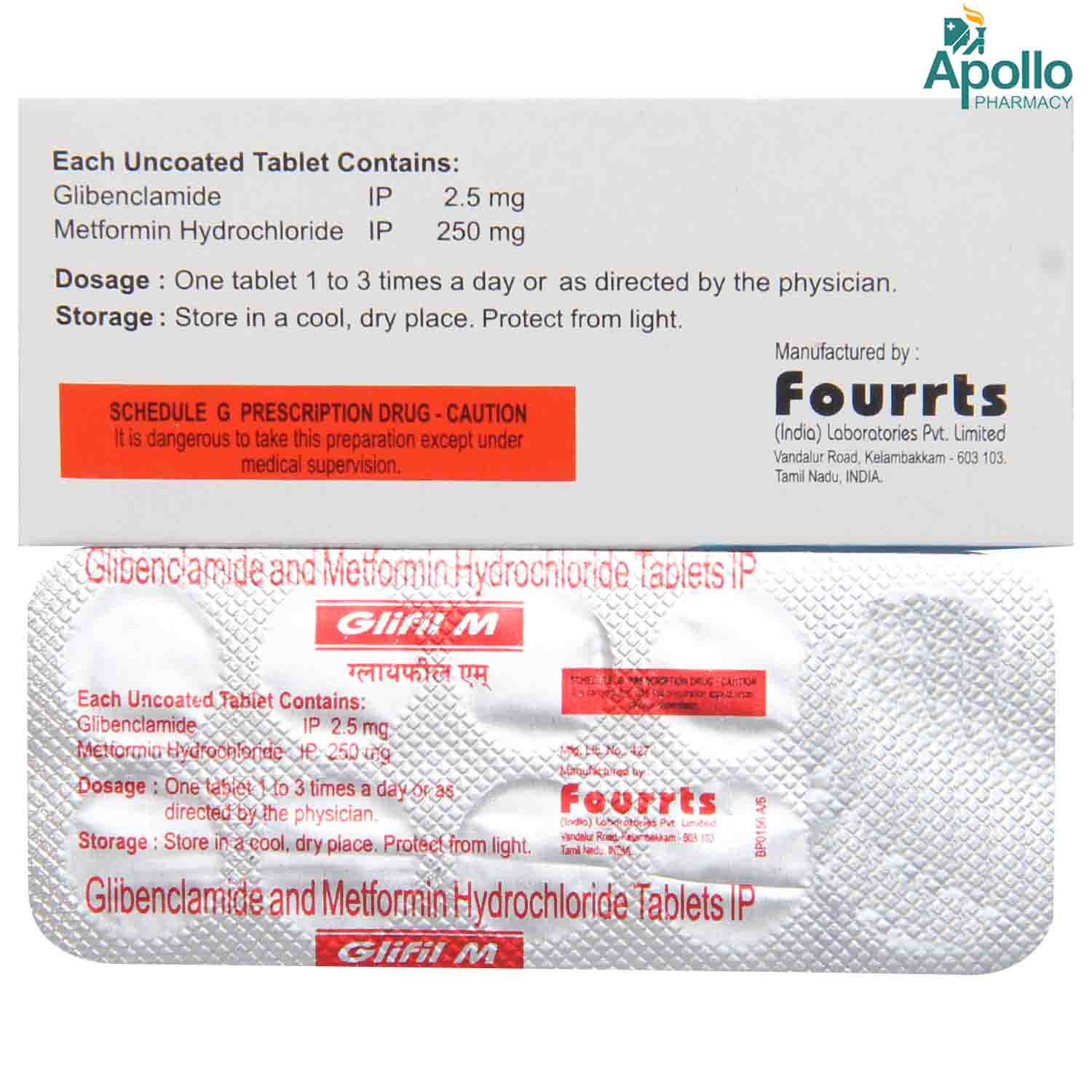Glifil M Tablet


MRP ₹20.5
(Inclusive of all Taxes)
₹3.1 Cashback (15%)
know your delivery time
Provide Delivery Location
Composition :
Manufacturer/Marketer :
Consume Type :
Expires on or after :
Return Policy :

Secure Payment

Trusted by 8 Crore Indians

Genuine Products
Therapeutic Class
Country of origin
Manufacturer/Marketer address
Disclaimer
Alcohol
Safe if prescribed
Alcohol may increase the risk of side-effects.
Pregnancy
Consult your doctor
Glifil M Tablet should be used with caution only if prescribed by a doctor in pregnant women as it may cause toxic effects to the fetus.
Breast Feeding
Consult your doctor
Breastfeeding mothers should not take Glifil M Tablet unless prescribed by your doctor.
Driving
Safe if prescribed
Glifil M Tablet may cause vision problems. So, it is not recommended to drive if your vision is blurred while using Glifil M Tablet .
Liver
Consult your doctor
Glifil M Tablet should be used with caution in patients with liver diseases. Dose adjustments may be necessary.
Kidney
Consult your doctor
Glifil M Tablet should be used with caution in patients with severe kidney impairment. Consult your doctor for further advice.
Children
Safe if prescribed
Glifil M Tablet is not recommended for use in children below 12 years of age.
Product Substitutes
About Glifil M Tablet
Glifil M Tablet belongs to the group of medications called ‘antidiabetic agents’ used in treating Type 2 diabetes mellitus. Type 2 diabetes is a chronic (long-lasting) condition that affects the way our body processes glucose. People with type 2 diabetes either do not produce enough insulin, or the insulin produced cannot perform its function in the body (insulin resistance).
Glifil M Tablet contains Metformin and Glibenclamide. Metformin works by reducing the sugar production by cells in the liver and delays sugar absorption from the intestines. Glibenclamide works by stimulating beta cells in the pancreas that produce insulin. Thus, insulin helps to remove sugar from the blood.
Take Glifil M Tablet as prescribed by your doctor. You are advised to take Glifil M Tablet for as long as your doctor has prescribed it based on your medical condition. Sometimes, you may experience stomach pain, nausea, diarrhoea, vomiting, headache or low blood sugar. Most of these side effects of Glifil M Tablet do not require medical attention and gradually resolve over time. However, if the side effects persist or worsen, please consult your doctor.
Do not consume if you are allergic to any components in the Glifil M Tablet . Glifil M Tablet is not recommended for children. If you are pregnant or planning for pregnancy, please inform your doctor before taking Glifil M Tablet . Glifil M Tablet should be used with caution in elderly patients. Avoid alcohol consumption with Glifil M Tablet as it may increase the risk of lactic acidosis (accumulation of lactic acid in the body). Drive only if you are alert after taking Glifil M Tablet .
Uses of Glifil M Tablet
Medicinal Benefits Mweb
Key Benefits
Glifil M Tablet contains Metformin and Glibenclamide. Metformin works by reducing the sugar production by cells in the liver and delays sugar absorption from the intestines. Glibenclamide works by stimulating beta cells in the pancreas that produce insulin. Thus, insulin helps to remove sugar from the blood. Together Glifil M Tablet decreases the elevated blood sugar level after the meal along with the recommended diet and exercise.
Directions for Use
Side Effects of Glifil M Tablet
- Nausea (feeling sick)
- Vomiting (falling sick)
- Diarrhoea
- Stomach ache
- Loss of appetite
Drug Warnings
Do not take Glifil M Tablet if you are allergic to metformin, glibenclamide or other contents. Glifil M Tablet may cause ‘lactic acidosis’ (buildup of lactic acid in the blood), characterized by abdominal pain, muscle cramps, vomiting, severe fatigue, and difficulty breathing. It is a life-threatening condition that requires immediate medical attention. Inform your doctor if you have any severe liver or kidney problems, as their normal functioning is required to eliminate excess lactic acid from the body. Do not consume excess alcohol, as it increases the risk of lactic acidosis. Inform your doctor if you have any hormonal problems, infectious diseases, or glucose-6-phosphate dehydrogenase - G6PD deficiency (an inherited condition that causes the breakdown of red blood cells).
Drug-Drug Interactions
Drug-Drug Interactions
Login/Sign Up
Co-administration of Glifil M Tablet and Iodamide can increase the risk of lactic acidosis (when the body produces too much lactic acid).
How to manage the interaction:
Taking Glifil M Tablet with Iodamide is generally avoided as it can result in an interaction, please consult your doctor before taking it.
Co-administration of Glifil M Tablet and Iobenzamic acid can increase the risk of lactic acidosis (when the body produces too much lactic acid).
How to manage the interaction:
Taking Glifil M Tablet with Iobenzamic acid is generally avoided as it can result in an interaction, please consult your doctor before taking it.
Co-administration of Glifil M Tablet with Metrizamide together can cause the risk of lactic acidosis (when the body produces too much lactic acid ).
How to manage the interaction:
Taking Glifil M Tablet with Metrizamide is generally avoided as it can possibly result in an interaction, it can be taken if a doctor has advised it. However, if you experience headaches, muscle cramps or pain, contact a doctor immediately. Do not discontinue any medications without consulting a doctor.
Co-administration of Iopydol with Glifil M Tablet can increase the risk of side effects.
How to manage the interaction:
Taking Glifil M Tablet with Iopydol is not recommended, please consult your doctor before taking it.
Co-administration of Glifil M Tablet and Iocarmic acid can increase the risk of lactic acidosis (when the body produces too much lactic acid).
How to manage the interaction:
Taking Glifil M Tablet with Iocarmic acid is generally avoided as it can result in an interaction. please consult your doctor before taking it.
Co-administration of Iodixanol with Glifil M Tablet can increase the risk of side effects.
How to manage the interaction:
Taking Glifil M Tablet with Iodixanol is not recommended, please consult a doctor before taking it. Do not discontinue the medications without consulting a doctor.
Co-administration of Glifil M Tablet and Iobitridol can increase the risk of lactic acidosis (when the body produces too much lactic acid).
How to manage the interaction:
Taking Glifil M Tablet with Iobitridol is generally avoided as it can result in an interaction. Please consult your doctor before taking it.
Co-administration of Ioversol with Glifil M Tablet can increase the risk of side effects.
How to manage the interaction:
Taking Glifil M Tablet with Ioversol is not recommended, please consult your doctor before taking it.
Co-administration of Iopamidol with Glifil M Tablet can increase the risk of side effects.
How to manage the interaction:
Taking Glifil M Tablet with Iopamidol is not recommended, please consult a doctor before taking it. Do not discontinue the medications without consulting a doctor.
Co-administration of Iotroxic acid with Glifil M Tablet can increase the risk of side effects.
How to manage the interaction:
Taking Glifil M Tablet with Iotroxic acid is not recommended, please consult your doctor before taking it.
Drug-Food Interactions
Drug-Food Interactions
Login/Sign Up
Drug-Diseases Interactions
Drug-Diseases Interactions
Login/Sign Up
Drug-Drug Interactions Checker List
- MICONAZOLE
- RITODRINE
- SALBUTAMOL
- BOSENTAN
- PHENYLBUTAZONE
- FLUCONAZOLE
- CHLORPROMAZINE
- DESMOPRESSIN
- DANAZOL
Habit Forming
Special Advise
- Glifil M Tablet shows optimum effects when you follow healthy lifestyle changes like weight loss, regular exercise, healthy diet, etc.
Diet & Lifestyle Advise
- Prefer eating a meal that contains plenty of vegetables, fruits and whole grains. Opt for non-fat dairy products and lean meats.
- Eat at regular intervals. Do not take a long gap between a meal or snack.
- Monitor your blood glucose levels regularly as advised by your doctor.
- Keep a check on your weight. Shed excess weight by exercising regularly.
- Do not take stress as it shows the effect on blood sugar levels.
- Quit smoking and limit alcohol intake.
All Substitutes & Brand Comparisons
RX
Out of StockSemi Glucodol Tablet 10's
Diacardus Pharmacy Pvt Ltd
₹29.5
(₹2.95 per unit)
59% COSTLIER

Have a query?
Buy best Diabetics products by
Torrent Pharmaceuticals Ltd
Sun Pharmaceutical Industries Ltd
Eris Life Sciences Ltd
Intas Pharmaceuticals Ltd
Lupin Ltd
Micro Labs Ltd
Mankind Pharma Pvt Ltd
Lloyd Healthcare Pvt Ltd
Alkem Laboratories Ltd
Abbott India Ltd
Glenmark Pharmaceuticals Ltd
Cipla Ltd
Macleods Pharmaceuticals Ltd
Wockhardt Ltd
Dr Reddy's Laboratories Ltd
Primus Remedies Pvt Ltd
USV Pvt Ltd
Aristo Pharmaceuticals Pvt Ltd
Emcure Pharmaceuticals Ltd
Alembic Pharmaceuticals Ltd
Ipca Laboratories Ltd
La Renon Healthcare Pvt Ltd
Ajanta Pharma Ltd
Medley Pharmaceuticals Ltd
East West Pharma India Pvt Ltd
Elbrit Life Sciences Pvt Ltd
Corona Remedies Pvt Ltd
Hbc Life Sciences Pvt Ltd
Sinsan Pharmaceuticals Pvt Ltd
Ranmarc Labs
Mitoch Pharma Pvt Ltd
Zydus Healthcare Ltd
Sanofi India Ltd
Akumentis Healthcare Ltd
Fusion Health Care Pvt Ltd
Unison Pharmaceuticals Pvt Ltd
Jubilant Lifesciences Ltd
Novo Nordisk India Pvt Ltd
Tas Med India Pvt Ltd
Blue Cross Laboratories Pvt Ltd
Msn Laboratories Pvt Ltd
Eswar Therapeutics Pvt Ltd
Indoco Remedies Ltd
Q Check Pharmaceuticals
Alteus Biogenics Pvt Ltd
Anthem Bio Pharma
Franco Indian Pharmaceuticals Pvt Ltd
Systopic Laboratories Pvt Ltd
Panacea Biotec Ltd
Zydus Cadila
Biocon Ltd
Edoc Life Sciences Pvt Ltd
Koye Pharmaceuticals Pvt Ltd
Arkas Pharma Pvt Ltd
Diacardus Pharmacy Pvt Ltd
Elinor Pharmaceuticals (P) Ltd
Remedy Life Sciences Pvt Ltd
Saan Labs
Talent India Pvt Ltd
Jarun Pharmaceuticals Pvt Ltd
Capital Pharma
Shrrishti Health Care Products Pvt Ltd
FDC Ltd
Leeford Healthcare Ltd
Nirvana India Pvt Ltd
Elder Pharmaceuticals Ltd
Eli Lilly and Company (India) Pvt Ltd
Glynis Pharmaceuticals Pvt Ltd
Zuventus Healthcare Ltd
Arrient Healthcare Pvt Ltd
Cadomed Pharmaceuticals India Pvt Ltd
Orris Pharmaceuticals
Akesiss Pharma Pvt Ltd
Bal Pharma Ltd
Biochem Pharmaceutical Industries Ltd
Knoll Healthcare Pvt Ltd
Lippon Pharma Pvt Ltd
Morepen Laboratories Ltd
Neucure Lifesciences Pvt Ltd
Opsis Care Lifesciences Pvt Ltd
Wallace Pharmaceuticals Pvt Ltd
Acmedix Pharma Llp
Converge Biotech Pvt Ltd
Erinyle Pharma
Indiabulls Pharmaceuticals Pvt Ltd
Ozone Pharmaceuticals Ltd
Retra Life Science Pvt Ltd
Alvio Pharmaceuticals Pvt Ltd
Geneaid Pharmaceuticals
Heal (India) Laboratories Pvt Ltd
Olcare Laboratories Pvt Ltd
Vasu Organics Pvt Ltd
Kotak Life Sciences
Lakshya Life Sciences Pvt Ltd
Proqol Health Care Pvt Ltd
Sanz Pharmaceuticals
Daylon healthcare pvt Ltd
Mcronus Lifescience Pvt Ltd
Natco Pharma Ltd
Orsim Pharma
Customers Also Bought





